Some helpful tips for the best fly control measures to reduce the numbers of annoying flies around your horses.
I have had my horses at home for about four years now. Flies found them immediately. Stable flies, face flies, biting flies, house flies, bot flies, horse flies, deer flies. And whatever those huge B57 bombers are that show up halfway through the summer. The battle is real!
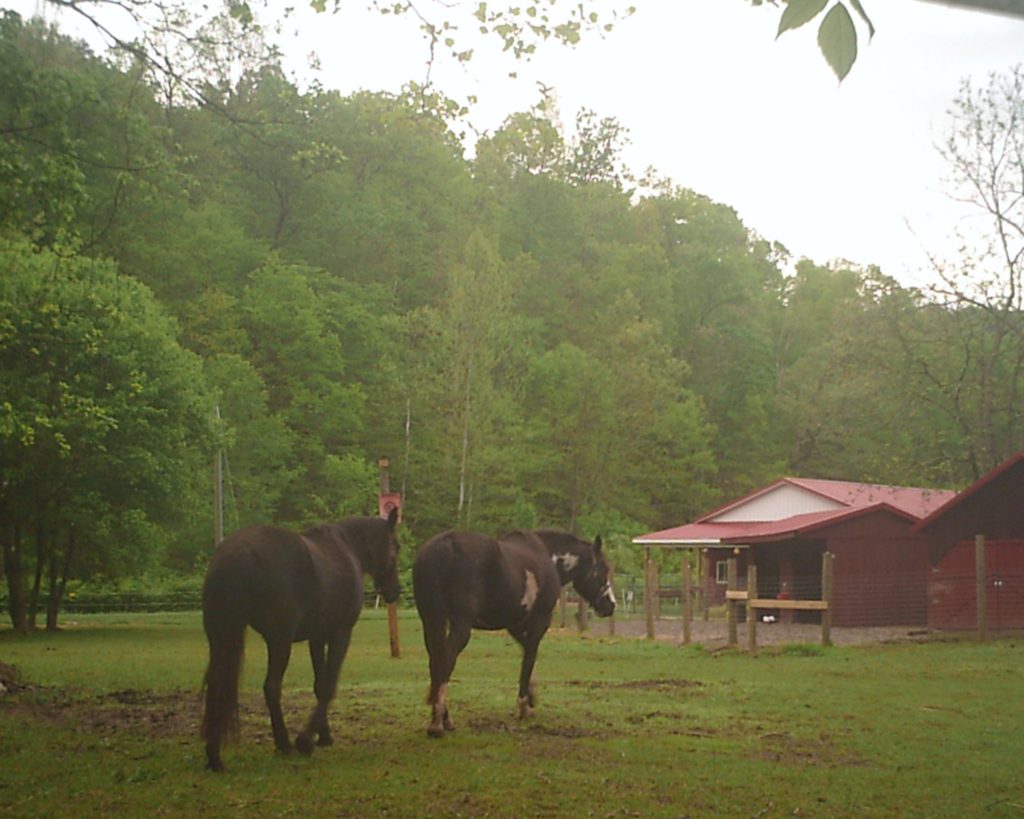
The Fly Nightmare
Flies are one of those many hordes of creepy-crawly creatures that my faith tells me God has a good reason for, but that doesn’t make me like them. I don’t like flies. Period.
Imaging trying to sleep in a room where the flies were incessantly buzzing inside the walls, and during the night hundreds of them found their way to the window frames and gathered on the inside of the windows.
When I was much younger, I lived in an old, old farm house for a while. The house had a dirt floor in the basement (think “cellar”), and additions had been built over the years with more necessity than skill. We suspected that something had crawled into an exterior wall and died. Flies followed, laid eggs, and the rest follows natural processes. We never smelled any rotting critter. The house was rented and the landlord would not respond to our pleas for help. I don’t remember how long this went on, but I remember sleeping on the floor in a room on the other side of the house for the duration. We kept that room closed off until the flies all died and could be cleaned up.
That experience may be part of my distaste for having flies around, but I haven’t met anyone who likes them, so maybe we all have the same feelings.
The Fly Problem
Dislike aside, there are many reasons to control flies on your property. House flies alone are suspected of carrying, and being capable of transmitting, up to 65 diseases. Studies have shown them to deposit high levels of bacteria on surfaces where they land. Different flies carry a variety of diseases that horses and other animals are susceptible to, as well.
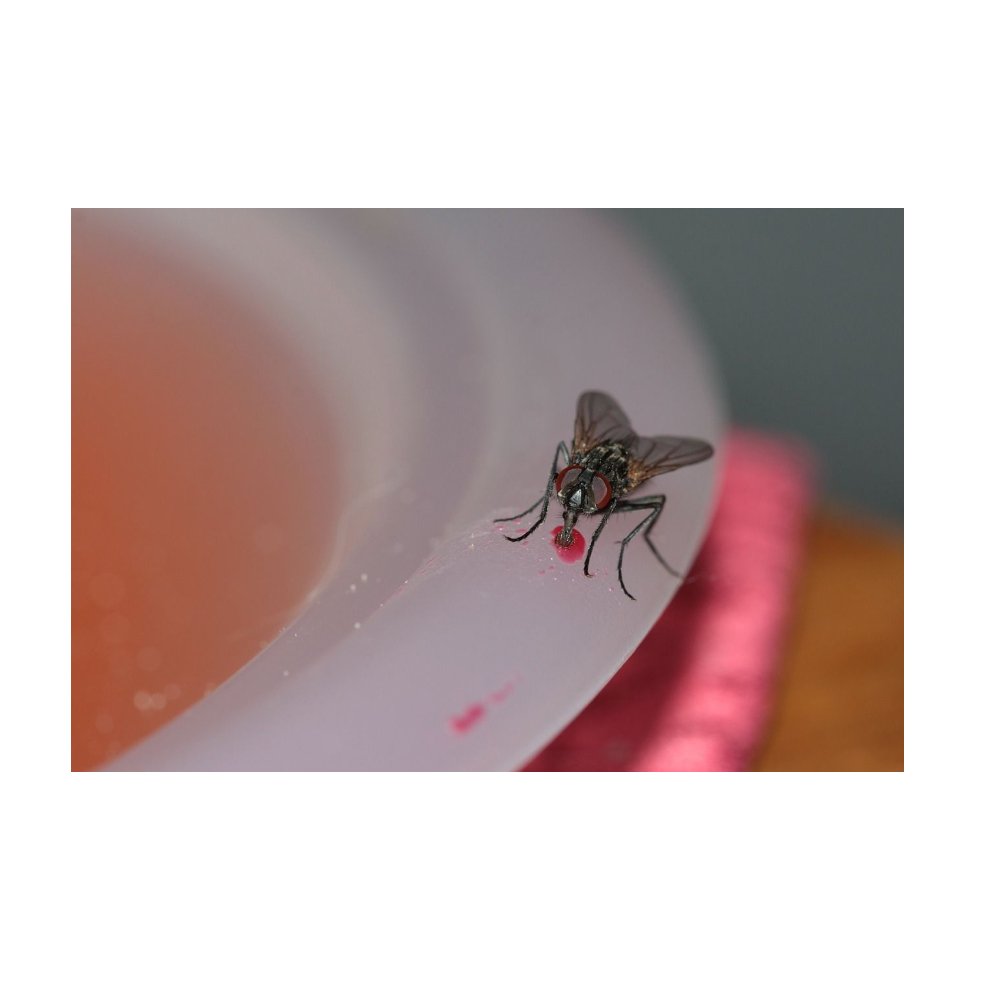
Additionally, many flies are capable of biting and leaving wounds on people and animals sensitive to them. Many types of flies are attracted to livestock like horses and will gather thickly around their faces and eyes.
The Battle
Different flies have to be fought with different battle tactics. I use a wide combination of tools to minimize their impact. There are also tools I have not used, because I don’t know enough about safely using them and I suspect some may do more damage than the flies they are intended to control. These include chemical broadcast spray systems and some feed through fly controls.
I know I can’t totally eliminate the enemy-flies on our farm. Here are some things that work to vastly reduce the fly armies.
1. Traps
Traps are probably my favorite, and I use multiple types.
- Green Netting Traps
- Liquid bag traps
- Tapes and Sticky traps.
- Horse and Deer Fly Traps
Green Netting Traps –
These can be a little tricky for me, but the longer I use them the more I appreciate them. They are probably my current favorite.
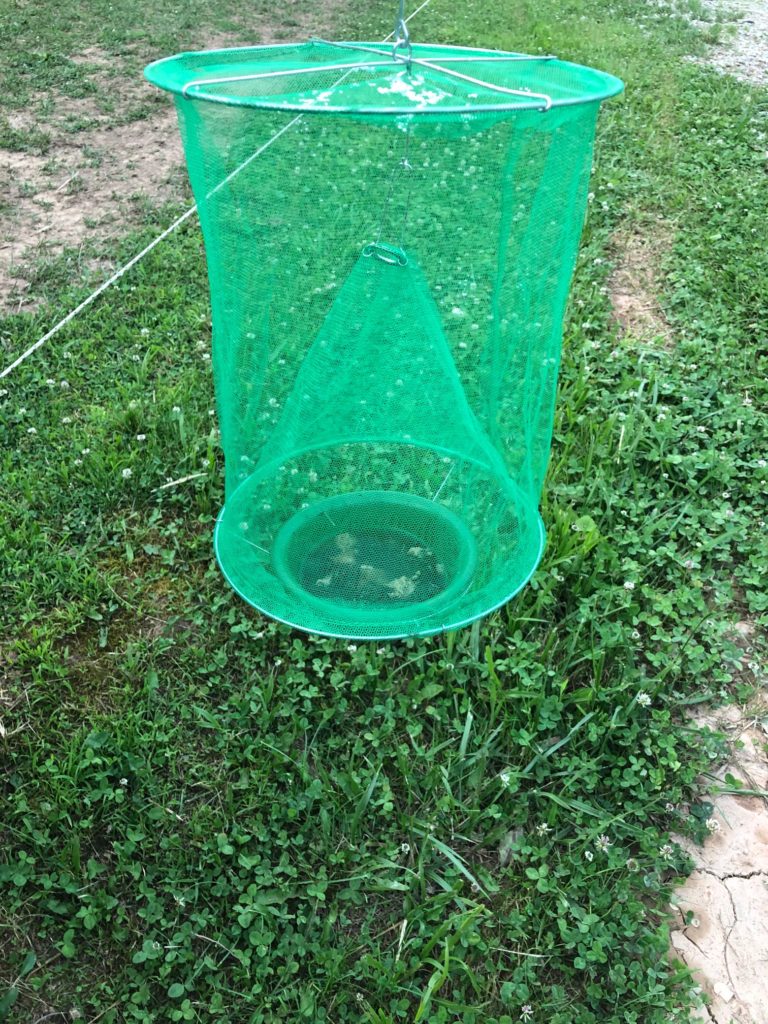
On the pro side – these are relatively inexpensive if you do some shopping. They are easy to hang, and incredibly effective.
The cons are that you need to keep a close eye on the bait cup and experiment to see what works for you. I have cats and wild critters, so when I started out using stinky salad shrimp or canned cat food, the whole trap would be torn down and the bait stolen. So I would mix a healthy amount of manure or even dog poop with canned cat food. The flies love it, but the cats and raccoons don’t. The bait bowl becomes quite nasty, and it seemed like some of the traps would quit working after a while. Currently, I am trying the bait packets that dissolve in water. These are intended for use in re-usable wet bag traps, and they do create more stink. And use gloves – even with the bag closed your hands will absorb that odor! But traps that were no longer working are now busy again!
Keep the bait moist. It does attract and capture some moths, but I have never seen a honey bee – they don’t like the stink. Even though the bait is stinky, it’s small, and the dying flies don’t add to the smell because they air dry. I put these just outside my pastures. I also hang one in my hay bale vegetable garden.
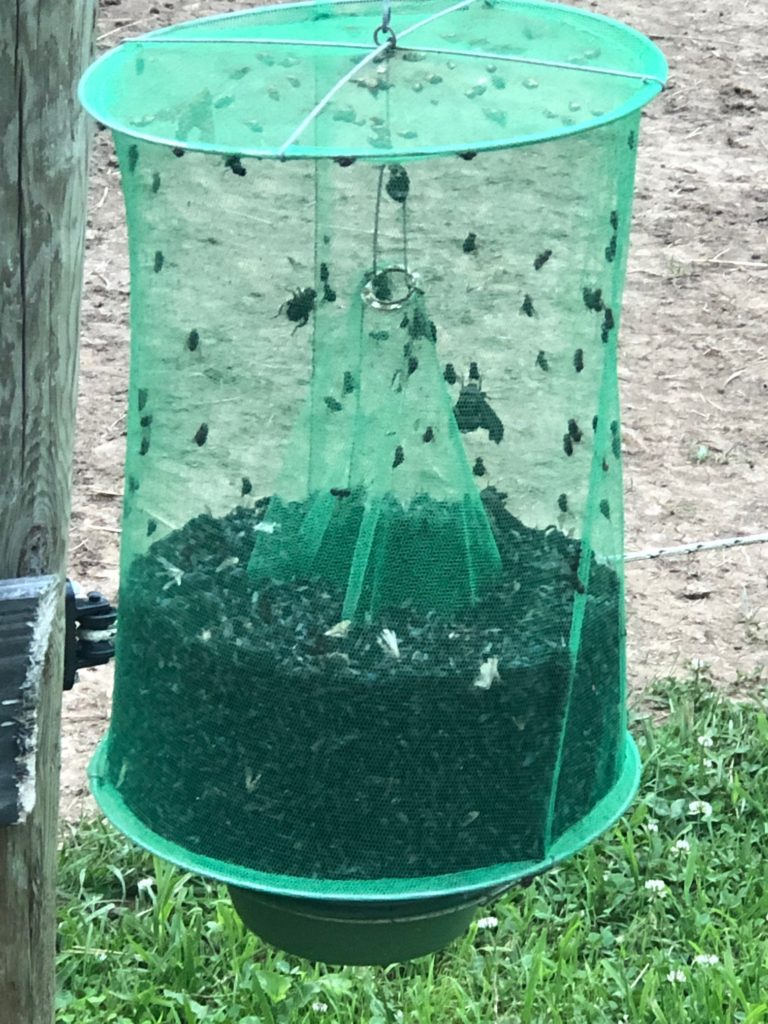
Liquid Bag Traps
I have a love-hate relationship with these traps. Again, they are very effective, though occasionally I seem to get a dud that doesn’t attract the flies as well. They are pretty cheap, and easy to hang on the fences and gates. Experiment with different brands to find what works best in your area.
But don’t stand downwind! These things stink from the bait and the drowned, decomposing flies. I dread having to get near them when it’s time to replace them.
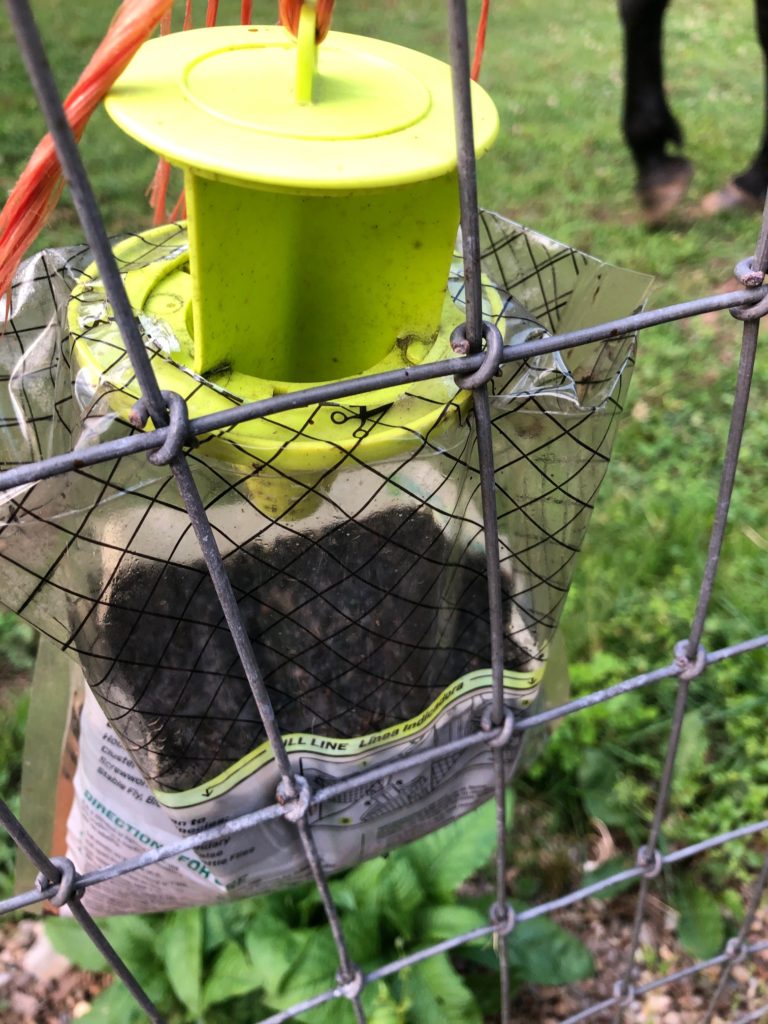
The things we endure for our horses!
Tapes and Sticky Traps
These include the old-fashioned, inexpensive flypaper – same product I remember from the barns of my childhood. Little cardboard tubes you open one end, hang the other on a nail and pull the sticky coil of goo out to flap around in every breeze.
Who else remembers accidentally walking into one of these to a disastrous end? Maybe that’s why I don’t have these….
But there are modern versions, including some that have special holographic patterns that are believed to attract some species of flies. The biting stable flies – often seen drawing blood on your horses legs and yours – are said to be only attracted to certain sticky traps.
Some complaints about these traps are due to the rare bird entrapment in the sticky glue, presumably because the bird was attracted to a free fly meal. Some are even made with cages to prevent this problem. I have also seen people make an enclosure out of chicken net to keep birds out of the glue.
Horse and Deer Fly Traps
Sticky traps are also sometimes used to combat the large biting horse flies and deer flies – usually in combination with a large black ball as a visual lure.
I use a visual trap quite successfully for these flies, but it uses black plastic, Plexiglas sheets and soapy water to kill these aggressive flies. See more on these flies and the special traps for them in this post: https://randomcanyoncrafts.com/trap-and-kill-those-huge-biting-horseflies/
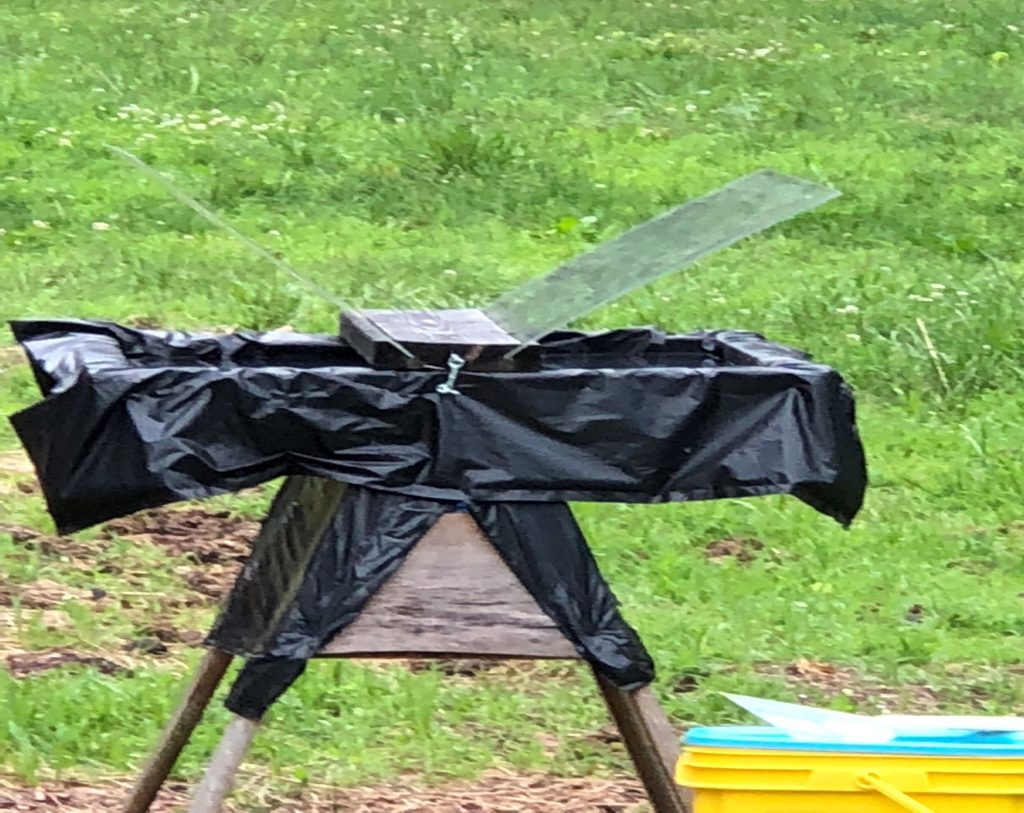
2. Physical Deterrents
- Fans
- Fly Masks
- Fly sheets
- Shade
- Tails, manes, forelocks
Fans
My horses are quite fond of their fans. They are set up in the three-sided run-in, and the horse have access to them from two of their three pasture areas. By installing them in the shaded run-in, the fans give significant relief from flies of all types.
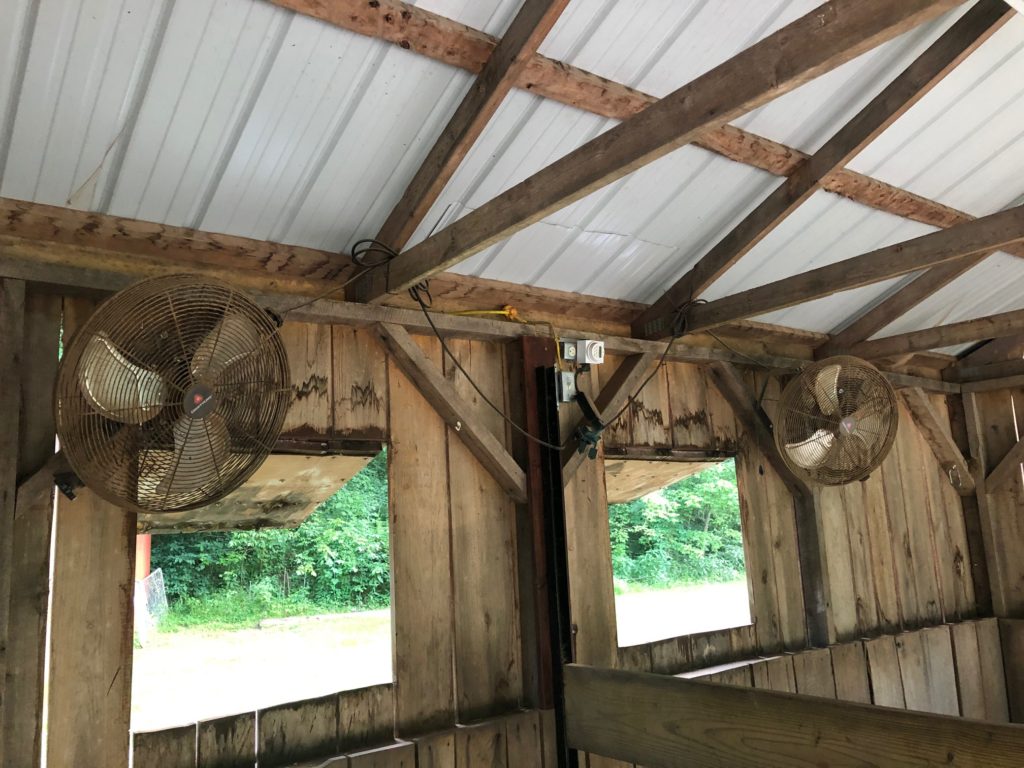
My fans are set up on timers and motion sensors. The timers mean the fans will run from 7 AM to 7 PM in full summer. If the horses come in to the run-in during those hours, the motion sensor will activate the fans. If they go back out to graze, the fans will turn off after 10 – 15 minutes of no movement.
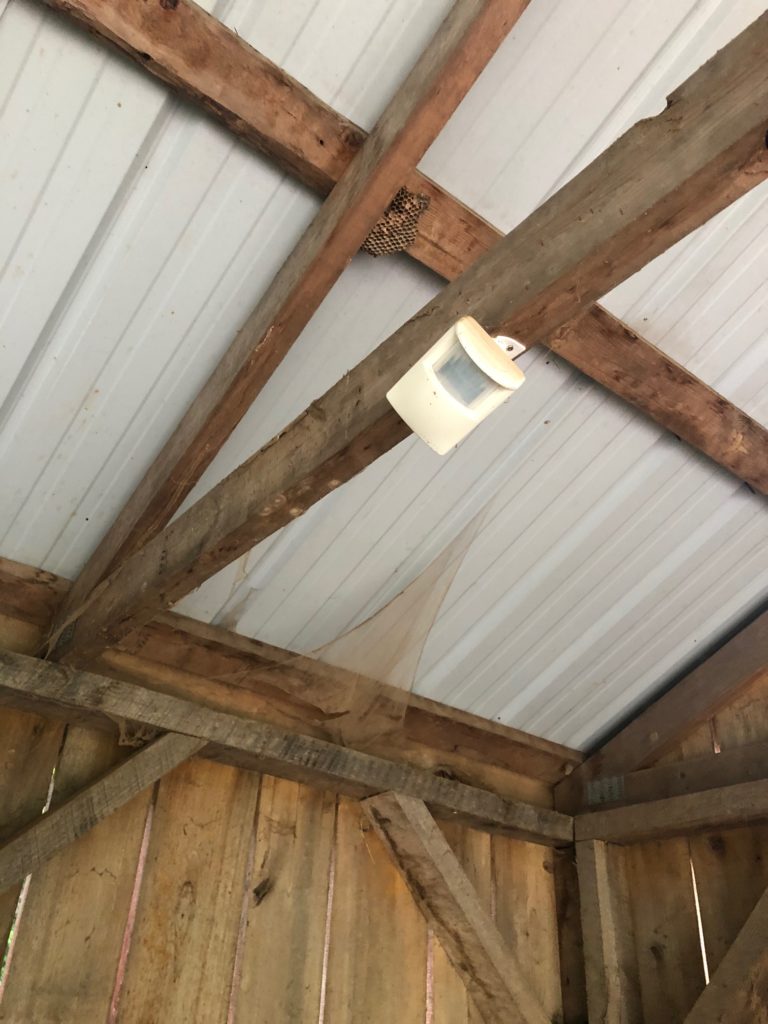
Interestingly, if the horses are dozing, and don’t move often enough to keep the fans running, they have learned to toss their head or flick their tails to start up the fans again.
Fly Masks and Fly Sheets
My horses accept fly masks and fly sheets very well. I often use these physical fly barriers when the horses are rotated to the field without fans. In this field they have water, and plenty of shade in the woods, but no source of electricity to run the fans. The woods give them some shelter from some flies, but the masks also help.
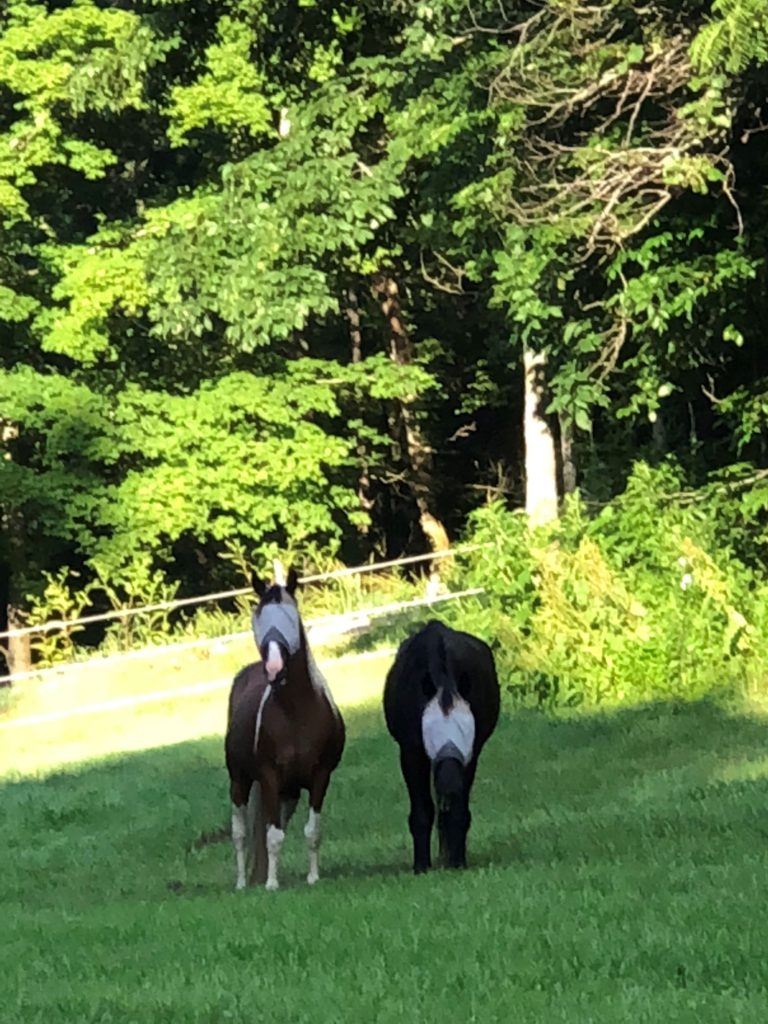
I have found that some flies – especially the big horse flies, can bite right through the mesh fly sheets. They will actually leave blood trails on the white mesh.
Another advantage to the white mesh fly sheet is that in really hot weather, I think it is cooler than my mare’s black coat.
Shade
Many flies seem to prefer sunny places over shade. When the flies are really annoying, my horses will find their favorite spot in the woods that border the pasture. They will stand in the shadiest spot, head-to-tail to chase the lingering flies.
When my horses were at boarding facilities, it was a common practice to put the horses in the barn during the day, and allowed out to graze at night. I understand the concept and while I never disagreed, I prefer to allow the horses to choose on their own.
With a three-sided run-in, they can also choose to share a stall to use the head-to-tail method of chasing flies.
Manes, Tails and Forelocks
My horses live as natural a horse life as possible, considering they are captive in the pastures. They have the freedom to move around day and night. Their tails and manes aren’t braided while they are in the pasture.
I just choose not to remove any barrier from flies. That said, I understand that hairy ears can attract some other bugs and burrs. I do have to shorten my horses tails in the winter to prevent iceballs from forming. otherwise, I try to leave them pretty natural.
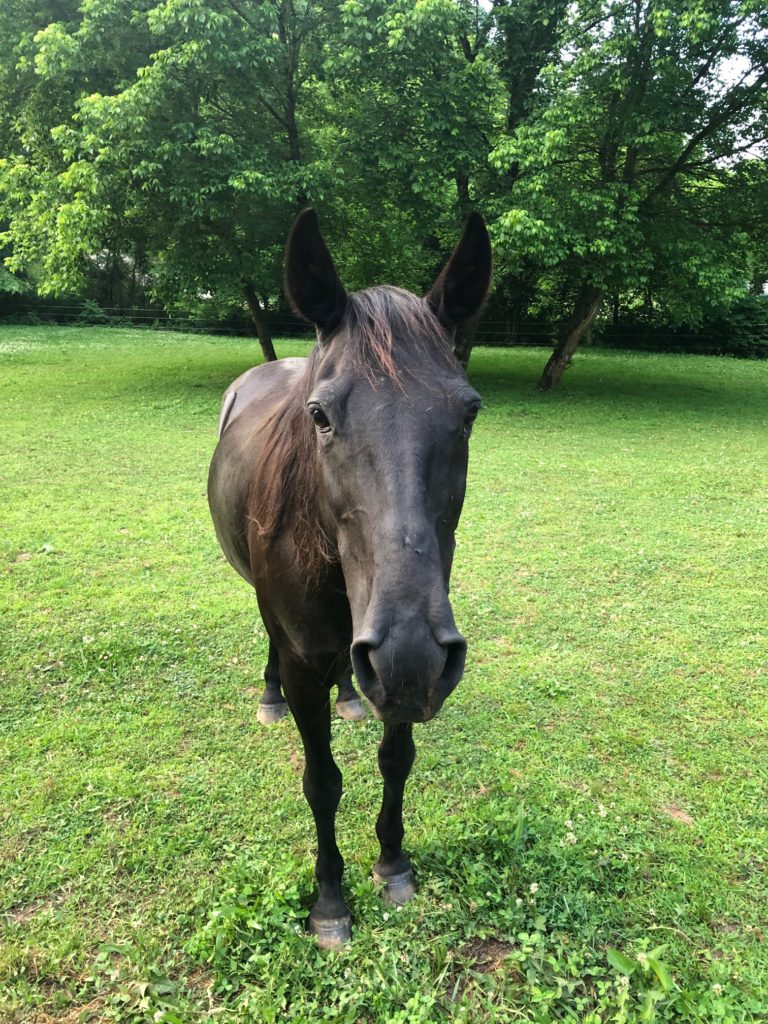
3. Biological Warfare
- Parasitic Fly Wasps
- Hummingbirds
- Other bird species
- Bats and Frogs
- Dragonflies and Other Beneficial Insects
Parasitic Fly wasps
These include Fly Eliminators from Arbico Organics and Fly Predators from Spalding Labs. There are other suppliers, but these are the two I have tried so far. I have been quite pleased with the results. Both companies have good customer service and supply lots of information.
These tiny wasps are not a hazard to animals or people. They are supplied on a recurring schedule throughout the fly season. The ones I have used arrive as rice-sized little bits in sawdust. They are sold in quantities that depend on how many horses you have and at frequencies you select. Their life span is much shorter than the fly lifespan, so they have to be replenished all season. They are applied all around the farm.
I have been using these wasps for four years now, and I do honestly believe they reduce the fly populations. Each year seems to be better, but there are really too many variables to be certain.
These tiny wasps locate and then lay their own eggs in fly pupae. When the wasp eggs hatch, the larvae feed on the fly pupae, killing the fly before it can mature. They do not control adult flies, and they only manage a percentage on the existing fly population.
Some folks claim they do not use these parasitic wasps because they have chickens and the chickens feed on the wasps. The suppliers suggest that you hang the bags of wasps instead of spreading them if you do have chickens.
Also, if you have a lot of horses, these may not be as cost effective. And if you have neighbors with horses, you may be fighting a losing battle using the parasitic wasps. Unless you can convince your neighbors to use them, as well.
Hummingbirds
I don’t really know how many flies our hummingbirds consume, if any. I do notice a decline in mosquitoes on our porch when the hummers are active. That alone would endear them to me, but flies are also on their menu. We encourage the hummingbirds with feeders and with our wildflower and perennial flower beds. They entertain us all summer with their amazing aerial displays. I hope they also grab some flies.
Other Bird Species
Common North American insect-eating birds include violet-green swallows, tree swallows, barn swallows, bluebirds, purple martins, and cliff swallows, to name a few. While birds nesting in the barn can also be a problem, you can encourage them by providing nesting boxes.
Bats and Frogs
It has taken me a while to appreciate bats, but I do enjoy seeing them fly around the fields at dusk. I am not convinced they do much for the fly population, because flies are most active in daytime, when the bats are not. But any help is welcome and the gnats and mosquitoes are pests as well.
I can’t say that we do much to assist the frog population, though we certainly hear them a lot in the woods and wetlands around the farm. They are supposed to be great in the fly-eating department, so perhaps we need to find a way to market fly-eating frogs for horse farms!
Dragonflies and Other Beneficial Insects
We don’t have a pond, but we do have pools in our seasonal streams, so we see significant numbers of dragonflies. The ones we have are welcome as they also consume flies and mosquitoes.
Dung beetles, Hister beetles, beneficial nematodes and even specific fungus sprays are all marketed to control fly populations. While I have not purchased these options, I find them very interesting and will continue to learn about these options.
4. Hand to Hand Combat
- In fly season, my horses will come over and present a horse fly for me to smack and kill. They seem to understand that I can rid them of the painful biting fly. Any other time, if I smacked one of my horses, they would run. Not during horse fly season.
- I often find that even after smacking a large horse fly, it gets up, shakes its shoulders and flies away to bite again. So generally I try to watch where it lands and stomp it as well. Sorry if that sounds violent coming from Grandma HaHa, but war is war!
- A super duper fly swatter is always nearby during fly season.
- Keeping manure cleaned up in barn and dry-lot areas will reduce the fly populations where your horses loaf.
- Manure Management. We don’t have enough pasture to spread the manure from two horses. We have three smallish fields we rotate for grazing in the summer months. When we move the horses out of a field, we mow it to knock down the weeds they don’t eat. We drag a chain drag behind the mower to break up and spread out the manure in the that field. Then there are at least three – four weeks before the horses are back in that field. That allows the manure piles to dry up some or be rained in. The manure from the run-in and dry lot is picked up daily and goes to a dumpster. The local waste service takes the dumpster to the local landfill once a week, which seems to be enough to keep the flies down around the dumpster area.
5. Fly Sprays and Spots
While I have used fly sprays more in the past, they are expensive and short-lived. I do occasionally use a mostly herbal fly spray for farrier visits or for training sessions. The only flies that really bother us when riding are the horse flies and deer flies and they seem to be immune to spray repellents.
This year I am also using one of the newer fly spot products that is applied every two weeks. I would love to hear some opinions on these products.
We try to minimize the use of strong chemicals around the farm, so I am more inclined to use natural or herbal products. I clean the water troughs and feed pails with apple cider vinegar, and use diatomaceous earth and corn meal to keep the ants under control. Maybe I need to do a post on all that soon.
Things I have Not Tried Yet
Feed Through (IGR) Fly Control – Improvements were made to these to protect the environment, but I have yet to try this method. Some research shows that these products may also harm the fly-killing wasps I now use, so I have not given them serious consideration. The other downsides to these are that they can be pricey, and you have to start feeding early and feed all summer. My horses typically do not need grain or other supplemental feed for much of the summer. They do well on grass and hay. Getting them to eat a top dressed supplement all summer may be an issue.
Garlic Products – Another feed-through option with lots of supporters. I just don’t know enough about it to have an informed opinion.
Apple Cider Vinegar – Also with lots of anecdotal support, but not a lot of real research that I could find.
Area Pesticide Misters – Chemical sprays that indiscriminately kill good and bad. I admit I know little about these systems, but for a small farm, and having an aversion to using too many chemical products, I suspect I will not be installing this control.
Chickens and Guinea hens – I understand the benefits! But I haven’t gotten there yet. My horses were at one barn where the chickens roosted in the barn and pooped everywhere. It kind of discouraged me from wanting my own. Maybe, some day.
The battle continues
In spite of all of our efforts, my farm is not fly free. While we have less flies than any of the boarding barns I was used to, they are still a fact of horse life.
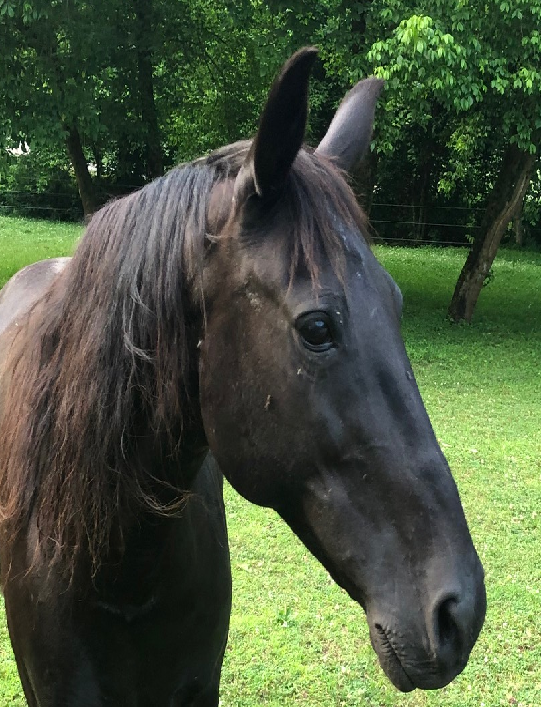
While winter is not my favorite season, I am thankful that we live in an area with distinct seasons. It means we get a break from the flies, and many other creepy crawlies. I lived in Georgia for a time, and the bugs were a year around reality. It made me appreciate the winter respite from the bugs here in West Virginia.
Please share your experiences with controlling flies
I would love to hear your comments regarding your experiences with horses and the flies that plague them. Please share your successes and even your failures. We can learn from each other and help our beautiful horses at the same time!
You might also like this post: https://randomcanyoncrafts.com/trap-and-kill-those-huge-biting-horseflies/
Leave a Reply